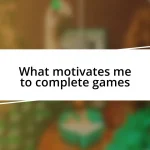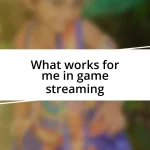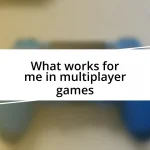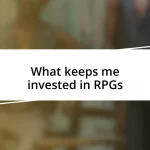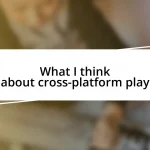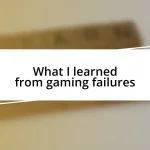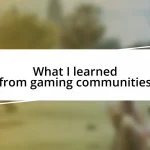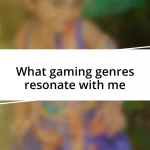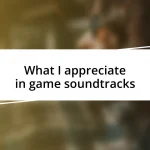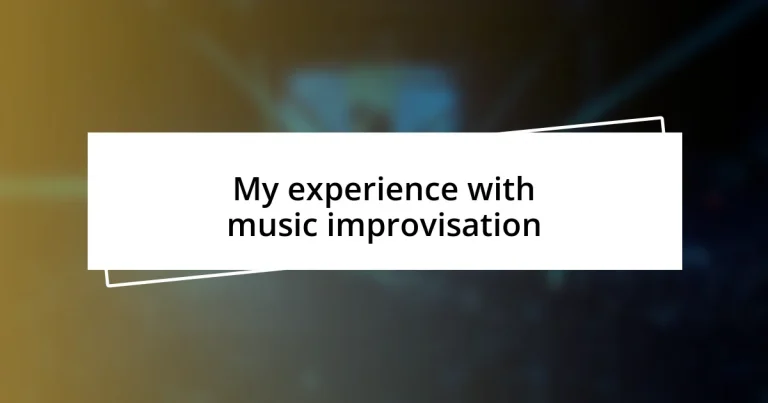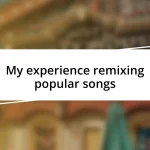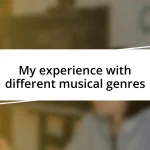Key takeaways:
- Improvisation fosters creativity and collaboration, enabling musicians to express emotions and connect deeply with one another.
- Key techniques such as active listening, using motifs, and embracing silence enhance the improvisational experience and encourage spontaneity.
- Personal experiences in improvisation highlight its transformative power, allowing for emotional release and creating bonds that transcend musical expression.
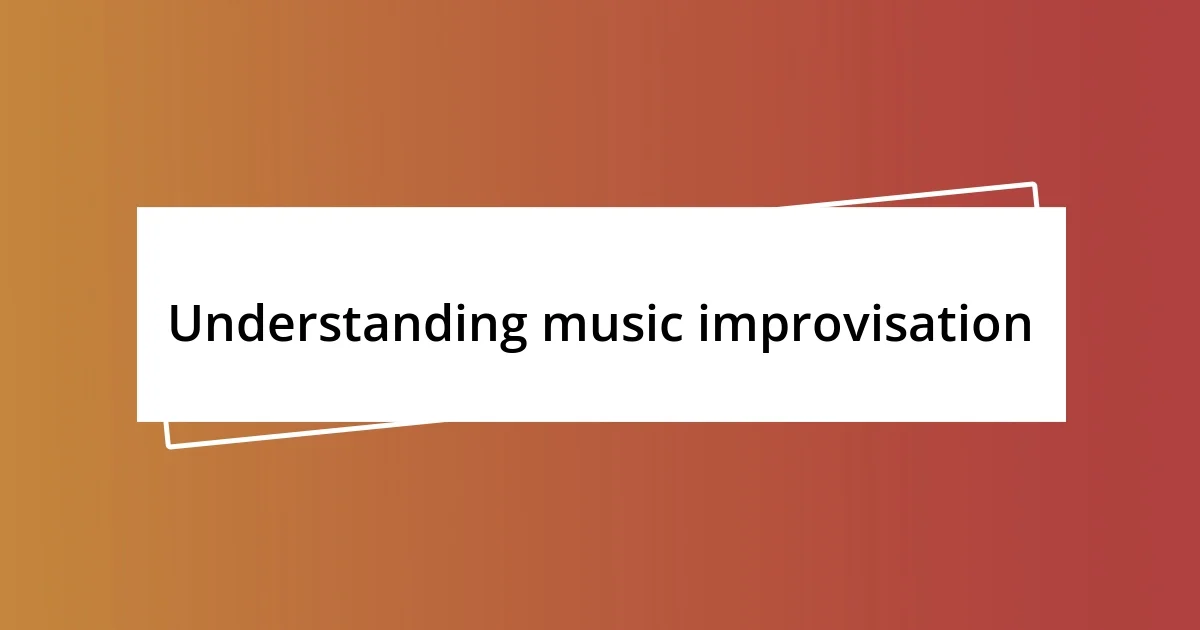
Understanding music improvisation
Understanding music improvisation is about embracing spontaneity and the unpredictability of creation. I remember the first time I sat in a circle with fellow musicians, each of us afraid yet eager to take the plunge. What struck me most was the liberation that came from knowing there were no wrong notes, only opportunities to express and connect.
As I delved deeper into improvisation, I discovered it wasn’t just about technical skill; it was also about listening. Each note played or sung carried with it an emotional weight that mirrored the atmosphere and feelings of the moment. Have you ever felt that rush of adrenaline when you respond to a fellow musician’s cue? It’s like a conversation, where you’re not just waiting for your turn to speak, but actively engaging in a dialogue that flows and evolves.
I often think of improvisation as a dance between structure and freedom. You have some guidelines, like scales and rhythms, but within those boundaries lies boundless creativity. One evening, I found myself lost in a long jam session, where time seemed to dissolve. I was swept away by the music, realizing that in those moments of improvisation, I was not just an individual artist but part of a greater whole. Isn’t it fascinating how music can transform us, inviting us to express our innermost feelings and thoughts?
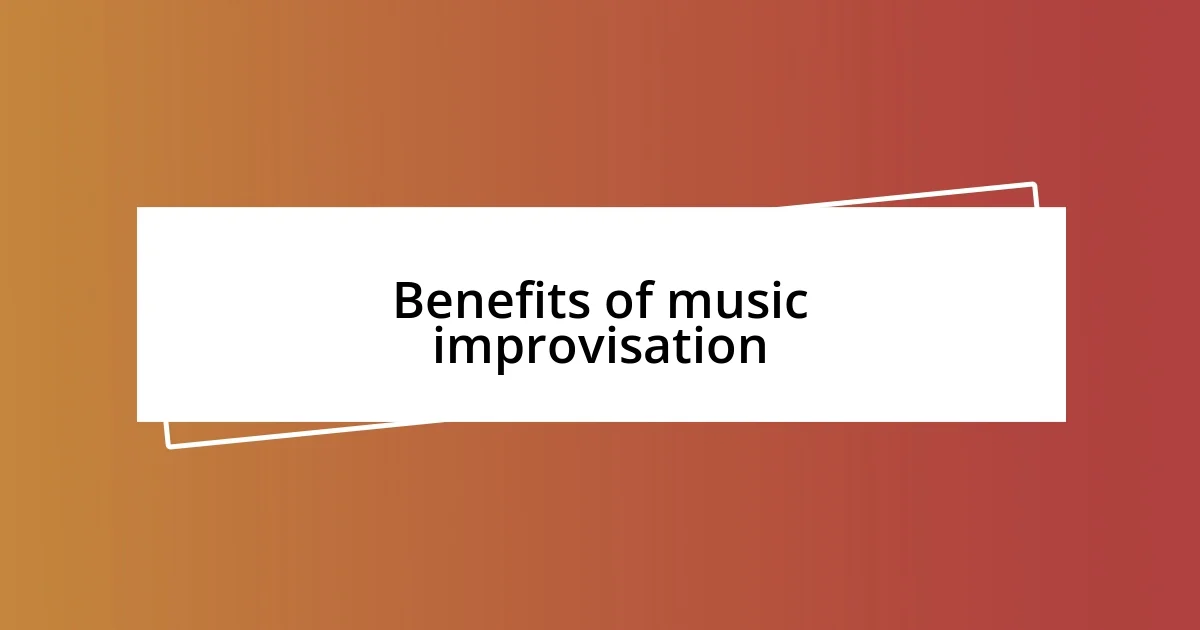
Benefits of music improvisation
Improvisation in music offers unparalleled freedom, allowing us to express ourselves in ways that structured compositions sometimes cannot. I remember a jam session where, out of nowhere, a beautiful melody emerged from a spontaneous chord progression. It felt like each musician instinctively contributed to this collective voice, creating something unique and memorable. This experience highlighted for me how improvisation fosters creativity and collaboration among artists, enhancing our musical vocabulary and expanding our expressive potential.
Beyond creativity, music improvisation also sharpens our listening skills. I often found myself paying close attention to the nuances in my fellow musicians’ playing, reacting in the moment rather than sticking to a preconceived plan. One night, during an informal gathering, I stumbled upon a rhythm that resonated with a friend’s guitar riffs, and together we crafted a piece that felt like a vivid tapestry of sound. Through these moments, I learned that being present and responsive in improvisation not only enriches our own playing but fosters a deeper connection with others.
Another benefit I cherish from improvisation is its role in emotional expression and stress relief. There have been times when I felt overwhelmed, but picking up my instrument and improvising allowed me to channel those feelings creatively. One evening, after a tough day, I found solace in jamming alone, allowing each note I played to reflect my emotions. It was cathartic, reminding me that music can be a healing force, creating a space for us to process our experiences and connect with our innermost selves.
| Benefits of Music Improvisation | Impact |
|---|---|
| Fosters Creativity | Enhances spontaneous expression and musical conversations |
| Improves Listening Skills | Encourages active engagement and responsive playing |
| Emotional Expression | Provides a therapeutic outlet for stress and personal feelings |
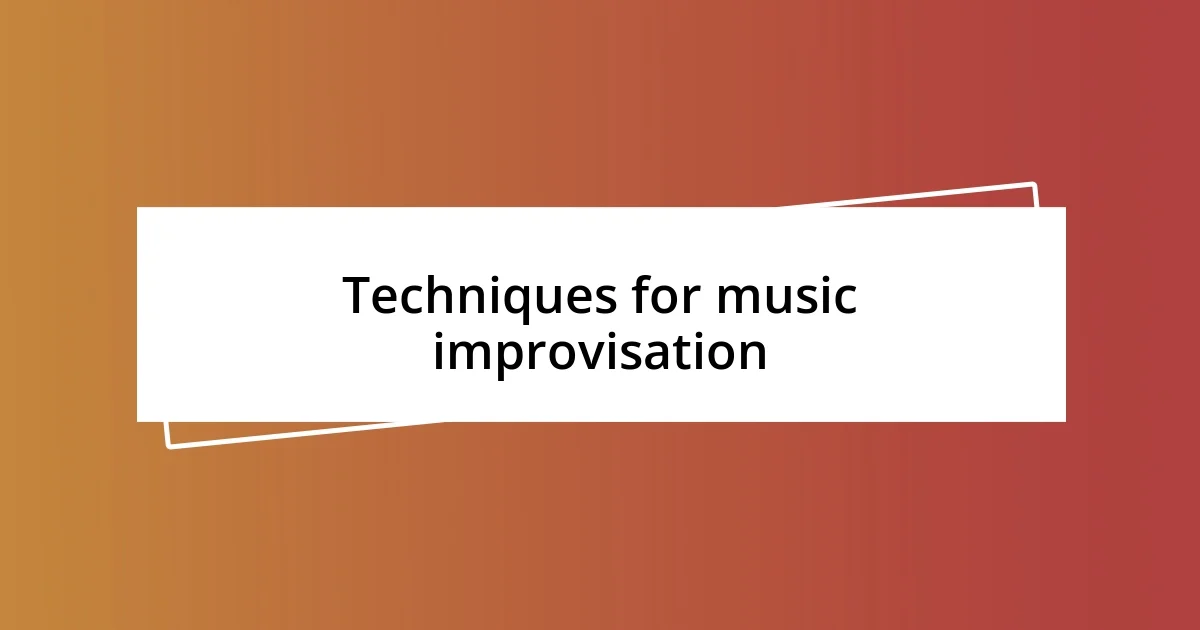
Techniques for music improvisation
Improvisation is a journey of exploration, and I’ve found several techniques that can truly elevate the experience. One technique that resonates with me is the use of motifs. When I play a simple melodic line repeatedly, I can see how it transforms as I experiment with tempo and dynamics. It’s like having a theme in a conversation; each variation adds depth and richness, allowing me to reflect emotions and intent in more intricate ways. I vividly recall a late-night session where I turned a basic motif into a heartfelt dialogue, weaving in elements of surprise with each repetition.
Here are some effective techniques I’ve employed in my own improvisation practice:
- Listening Actively: Focus on what others are playing; this allows for real-time responses.
- Motifs: Develop a simple melody or rhythm and build upon it throughout the improvisation.
- Call and Response: Engage with fellow musicians where one ‘calls’ a phrase, and the other ‘responds’, creating a dynamic dialogue.
- Push Boundaries: Don’t be afraid to experiment outside your comfort zone; try different styles, genres, or even instruments.
- Silence: Sometimes the most powerful statement comes not from what you play, but from the silence that allows listeners to absorb the music.
Embracing these techniques has made improvisation a thrilling exploration for me, intertwining structure with spontaneity in a beautifully unpredictable way. I still remember a moment where I experimented with silence, pausing just before a key change, and the impact was electric—almost like holding my breath together with the audience for what felt like an eternity. That balance of tension and release is where the magic of improvisation truly shines.
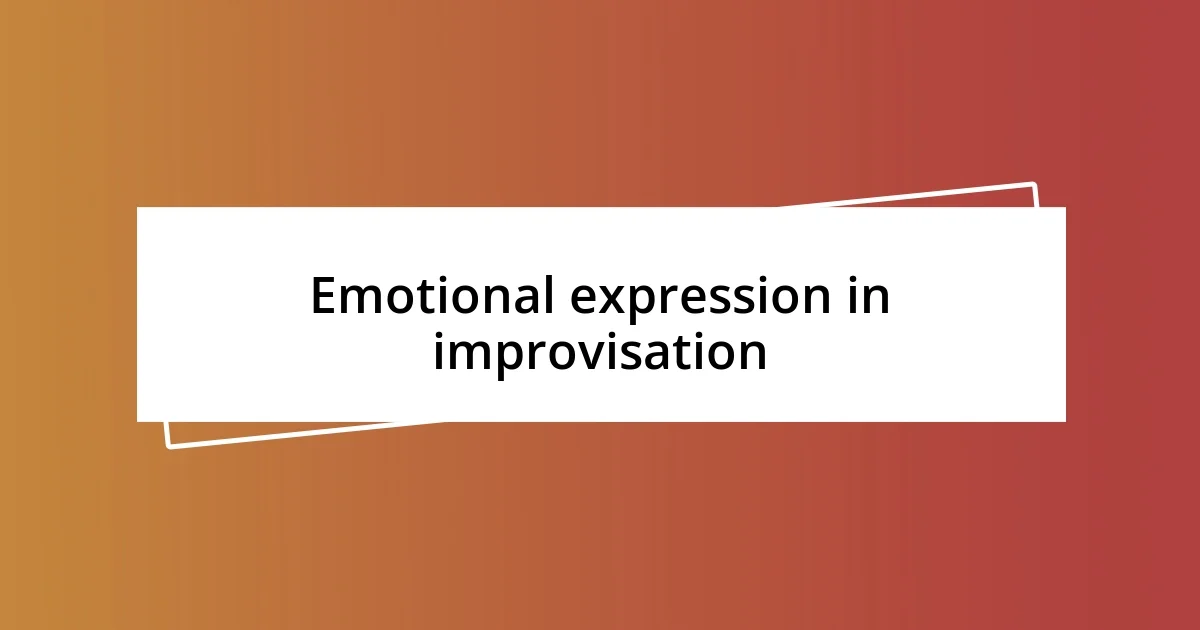
Emotional expression in improvisation
Improvisation allows for a profound release of emotion. I recall a particular evening where I felt an overwhelming mix of joy and sadness. As I played, each note seemed to pour out my heart—reflecting a blend of gratitude for the good times and mourning the bittersweet moments in life. It’s almost astonishing how, in that creative space, I could articulate feelings that often elude words. Have you ever experienced that rush of emotion cracking open in the middle of a jam? It validates my belief that music is a language unto itself.
What stands out to me in the emotional realm of improvisation is the personal connection to each note. You know that sensation when you strike a chord that resonates deeply within you? In a recent session, I found myself playing a minor scale that mirrored my introspection. It drew me in, and I felt as if I were sharing my story—not just with the audience, but with myself. It’s as if the music acts as a mirror, reflecting our inner turmoil and triumphs back at us, inviting us to explore those layers.
Ultimately, the beauty of improvisation lies in its unpredictability, especially how emotions can shift from one moment to the next. I vividly remember a time when I started playing in a somewhat somber mood, only to have it transform into exuberance as I interacted with fellow musicians. A single upbeat riff sparked laughter and a connection that transported us all. Isn’t it remarkable how quickly emotions can ebb and flow in such an organic way? That interplay not only deepens the experience but cements the notion that in music, we find a shared language that speaks to our unguarded selves.
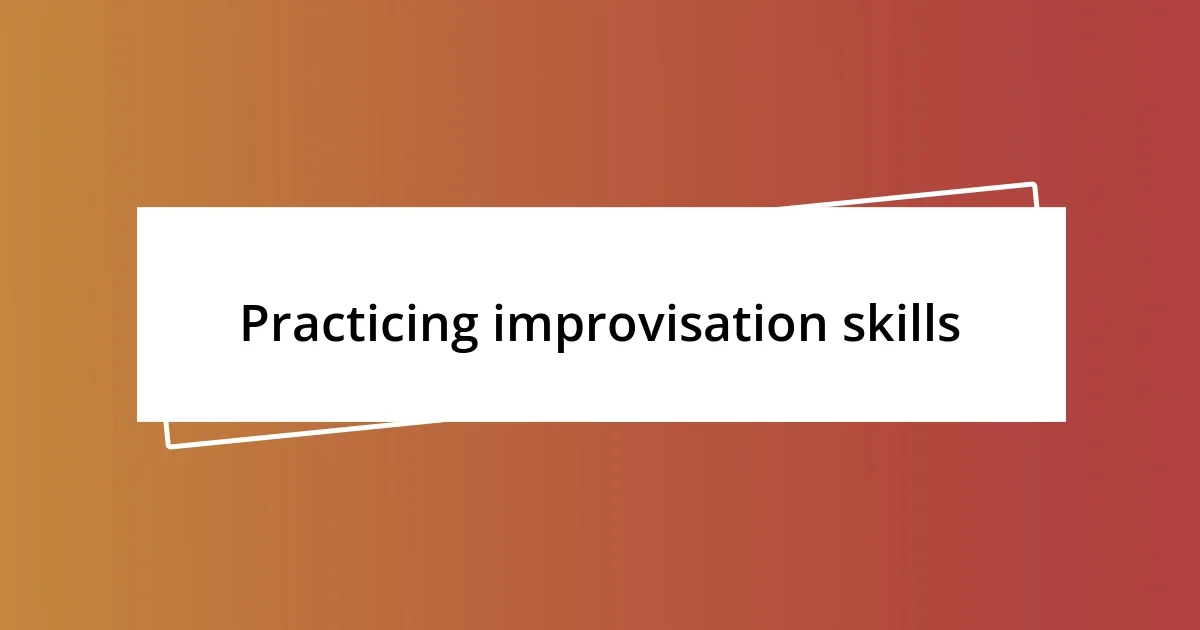
Practicing improvisation skills
Practicing improvisation skills has a significant impact on my overall musicianship. One of my favorite strategies is setting a timer for short bursts of playing—like five minutes—where I focus solely on a single technique or motif. This creates an interesting pressure to produce something on the spot, and I often end up surprising myself with the ideas that come out. Have you ever felt that rush of creativity when faced with a deadline? It’s exhilarating!
I also find incorporating different genres into my practice sessions helps to hone my improvisational abilities. For instance, I recently spent a week immersing myself in jazz. Playing with those complex chord progressions pushed my boundaries and opened my ears to new melodic possibilities. I remember one session where I stumbled upon a unique chord substitution that led me to a completely different sound than I’d typically create. Isn’t it fascinating how exploring unfamiliar territories can reveal hidden avenues of expression?
Above all, I believe that improvisation flourishes in a safe and supportive environment. Joining a local jam session was a game changer for me. The first time I shared my improvisations with others, my heart raced, but the encouragement I received from fellow musicians boosted my confidence. It’s moments like these that remind me that improvisation isn’t just about individual expression; it’s a shared experience where we can learn and grow together. How do you create a supportive space for your own musical journey?
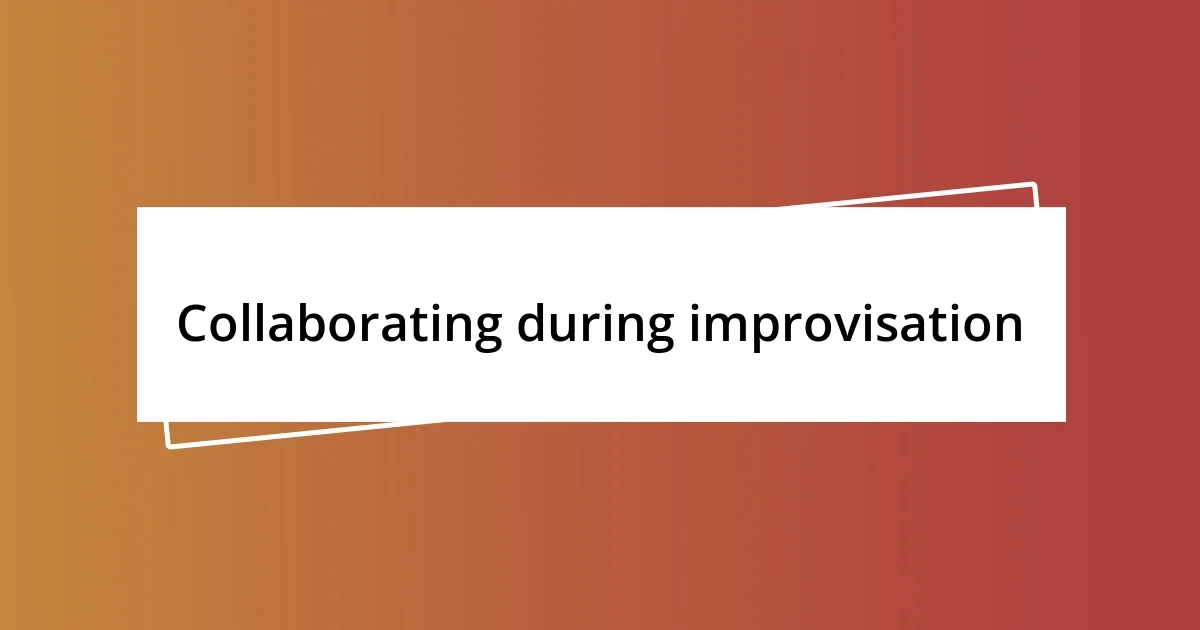
Collaborating during improvisation
When collaborating during improvisation, I often feel a unique synergy with the musicians around me. There’s nothing quite like the energy that arises when we tap into one another’s creativity. In one memorable session, I played alongside a bassist whose rhythms felt like they were guiding my every note. I still remember the thrill of each unexpected twist in our exchange—it taught me the importance of actively listening and responding to my peers. Have you ever felt that magical connection while jamming with others?
In my experience, collaboration often elevates the improvisational journey to new heights. For instance, during a recent workshop, a fellow guitarist introduced a syncopated beat that sparked an exhilarating dialogue between us. I found my fingers dancing over the fretboard, propelled by their unique rhythm. It’s precise moments like that where you realize the improvisation is less about individual artistry and more about crafting a collective masterpiece. Isn’t it breathtaking how the simplest idea can evolve into something so dynamic with the right partners?
Ultimately, collaborating reveals the heart of improvisation—a space where vulnerability and trust intertwine. I recall a night spent jamming with a group of musicians I’d just met. At first, I was hesitant to share my ideas, but as we began to feed off one another’s energy, I felt an openness that encouraged me to let go. It was as if we were all speaking the same musical dialect, allowing us to explore uncharted territory together. Have you ever experienced that feeling of community in your musical expressions? It’s truly a phenomenon that transforms mere playing into an unforgettable experience.
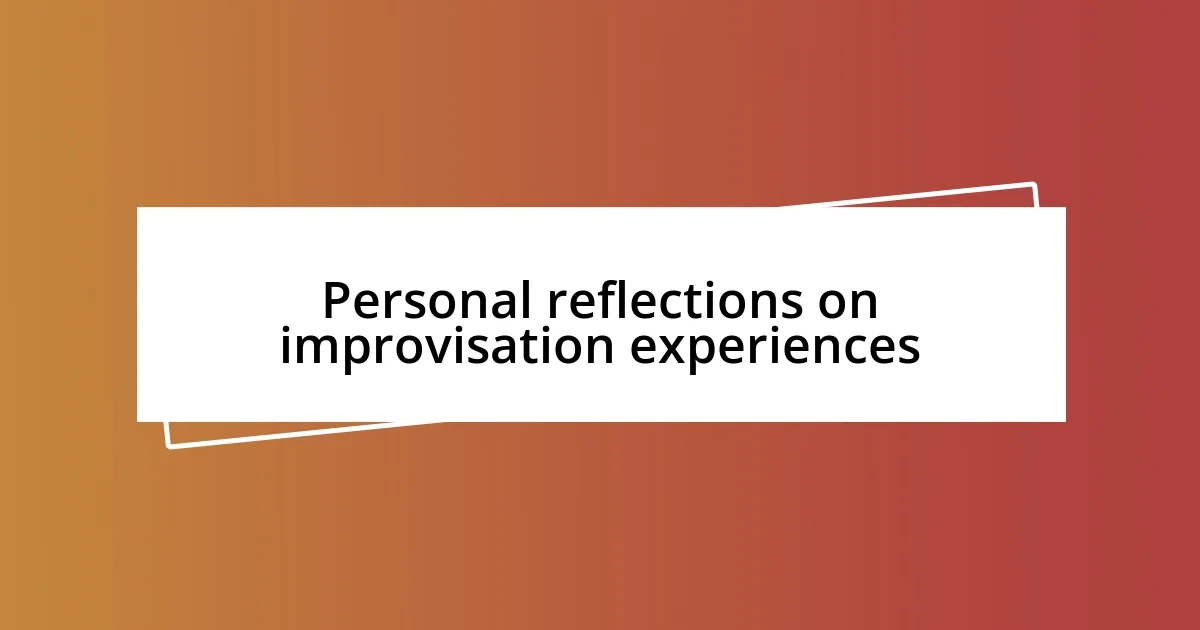
Personal reflections on improvisation experiences
There’s something truly magical about the moments when I lose myself in improvisation. One evening, I found myself at a small open mic night, where I decided to dive into a spontaneous performance despite the butterflies in my stomach. As I played, the supportive faces in the audience washed away my nerves. That night, I discovered a part of my musical voice I didn’t know existed. Have you ever let go in front of an audience and found freedom in the moment?
Reflecting on my improvisation experiences reveals how deeply personal and transformative they can be. I remember a jam session where I was exploring a new scale—only to hit a wrong note, which unexpectedly morphed into a hauntingly beautiful phrase. It was a reminder that even mistakes can lead to unexpected revelations in music. Isn’t it amazing how a tiny misstep can take the sound in a completely fresh direction?
The emotional connection formed while improvising is something I cherish greatly. I vividly recall the last time I played with my long-time musical partner; we exchanged solos that felt almost telepathic. Each phrase we played seemed to build on the other, creating an evocative narrative that pulled on my heartstrings. It’s moments like these that deepen my appreciation for improvisation as a dialogue, forging bonds that resonate well beyond the music. Have you ever felt that unspoken understanding with another musician?
